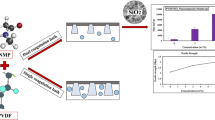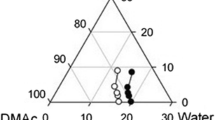Abstract
It was found that treatment in intense electric fields (i.e., electrical poling) changed the microstructure and filtration performance of polyvinylidene fluoride (PVDF) microfiltration membranes. The effect of temperature, sample size and time on the electrical breakdown of membranes was studied. It was shown that the hydraulic permeability and flux of the membranes can be tuned by changing the poling time. The effect of electrical poling on rejection and molecular weight cutoff was more significant. It was also found that the electrical breakdown of PVDF membranes is a gradual process and a long exposure time to an intense electric field can have adverse effects on the separation performance of the membranes.







Similar content being viewed by others
References
Ulbricht M, Schuster O, Ansorge W, Ruetering M, Steiger P (2007) Influence of the strongly anisotropic cross-section morphology of a novel polyethersulfone microfiltration membrane on filtration performance. Sep Purif Technol 57:63–73
Pinnau I, Freeman BD (2000) Formation and modification of polymeric membranes: overview. Membr Form Modif 744:1–22
Li JF, Xu ZL, Yang H (2008) Microporous polyethersulfone membranes prepared under the combined precipitation conditions with non-solvent additives. Polym Advan Technol 19:251–257
Matsuyama H, Takida Y, Maki T, Teramoto M (2002) Preparation of porous membrane by combined use of thermally induced phase separation and immersion precipitation. Polymer 43:5243–5248
Rezac ME, Leroux JD, Chen HM, Paul DR, Koros WJ (1994) Effect of mild solvent posttreatments on the gas-transport properties of glassy polymer membranes. J Membr Sci 90:213–229
Li RH, Barbari TA (1995) Performance of poly(vinyl alcohol) thin-gel composite ultrafiltration membranes. J Membr Sci 105:71–78
Mohr JM, Paul DR, Tullos GL, Cassidy PE (1991) Gas-transport properties of a series of poly(ether ketone) polymers. Polymer 32:2387–2394
Trushinski BJ, Dickson JM, Smyth T, Childs RF, McCarry BE (1998) Polysulfonamide thin-film composite reverse osmosis membranes. J Membr Sci 143:181–188
Kusuki Y, Shimazaki H, Tanihara N, Nakanishi S, Yoshinaga T (1997) Gas permeation properties and characterization of asymmetric carbon membranes prepared by pyrolyzing asymmetric polyimide hollow fiber membrane. J Membr Sci 134:245–253
Hinestroza J, De Kee D, Pintauro PN (2001) Apparatus for studying the effect of mechanical deformation on the permeation of organics through polymeric films. Ind Eng Chem Res 40:2183–2187
Puri P, Hinestroza J, De Kee D (2005) Transport of small molecules through mechanically elongated polymeric membranes. J Appl Polym Sci 96:1200–1203
Seol WH, Lee YM, Park JK (2006) Preparation and characterization of new microporous stretched membrane for lithium rechargeable battery. J Power Sources 163:247–251
Coster HGL, Farahani TD, Chilcott TC (2010) Membrane and separation system. PCT/AU2010/001582, Australia
Coster HGL, Farahani TD, Chilcott TC (2011) Production and characterization of piezo-electric membranes. Desalination 238:52–57
Kishimoto A, Koumoto K, Yanagida H, Nameki M (1991) Microstructure dependence of mechanical and dielectric strengths-i. porosity. Eng Fract Mech 40:927–930
Noskov MD, Cheglokov AA, Shapovalov AV (2001) Dynamics of the thermal instability evolution in dielectric breakdown. Rus Phys J 44:48–54
Castano VM, Espinosa G (1990) Studies on the fractal structure of the dielectric-breakdown in polymer sheets. Mater Lett 9:365–368
Zakrevskii VA, Sudar NT, Zaopo A, Dubitsky YA (2003) Mechanism of electrical degradation and breakdown of insulating polymers. J Appl Phys 93:2135–2139
Kressmann R (2001) New piezoelectric polymer for air-borne and water-borne sound transducers. J Acoust Soc Am 109:1412–1416
Darestani MT, Chilcott TC, Coster HGL (2014) Changing the microstructure of membranes using an intense electric field: filtration performance. J Membr Sci 449:158–168
Darestani MT, Coster HGL, Chilcott TC (2013) Piezoelectric membranes for separation processes: operating conditions and filtration performance. J Membr Sci 435:226–232
Darestani MT, Coster HGL, Chilcott TC, Fleming S, Nagarajan V, An H (2013) Piezoelectric membranes for separation processes: fabrication and piezoelectric properties. J Membr Sci 434:184–192
Granz B (1989) PVDF hydrophone for the measurement of shock-waves. IEEE T Electr Insul 24:499–502
Van der Bruggen B (2009) Chemical modification of polyethersulfone nanofiltration membranes: a review. J Appl Polym Sci 114:630–642
Ochoa NA, Masuelli M, Marchese J (2003) Effect of hydrophilicity on fouling of an emulsified oil wastewater with PVDF/PMMA membranes. J Membr Sci 226:203–211
Yuan W, Zydney AL (1999) Humic acid fouling during microfiltration. J Membr Sci 157:1–12
Xin Z, Zhao X, Suo Z, Chen Z, Runt J, Liu S, Shihai Z, Zhang QM (2009) Electrical breakdown and ultrahigh electrical energy density in poly(vinylidene fluoride-hexafluoropropylene) copolymer. Appl Phys Lett 94:162901–162903
Fukada E (2000) History and recent progress in piezoelectric polymers. Ultrason Ferroelectr Freq Control IEEE Trans 47:1277–1290
Ye YUN, Jiang Y, Wu Z, Zeng H (2006) Phase transitions of poly(vinylidene fluoride) under electric fields. Integr Ferroelectr 80:245–251
Gerson R, Marshall TC (1959) Dielectric breakdown of porous ceramics. J Appl Phys 30:1650–1653
Yiang KY, Yoo WJ, Krishnamoorthy A (2005) Effect of porosity on electrical stability of hydrocarbon polymeric low-k dielectric. IEEE T Electron Dev 52:2333–2336
Mochizuki S, Zydney AL (1993) Theoretical-analysis of pore-size distribution effects on membrane-transport. J Membr Sci 82:211–227
Yasuda H, Tsai JT (1974) Pore-size of microporous polymer membranes. J Appl Polym Sci 18:805–819
Darestani MT, Chilcott TC, Coster HGL (2013) Separation performance of PVDF membranes poled in intense electric fields. Sep Purif Technol 118:604–611
Meenakshi G, Khare ML, Bhatnagar CS (1985) Charge characteristics of thermomagnetically treated poly(vinylidene fluoride) films. Acta Polym 36:578–580
Shepard JF, Moses PJ, Trolier-McKinstry S (1998) The wafer flexure technique for the determination of the transverse piezoelectric coefficient (d(31)) of PZT thin films. Sensor Actuat a-Phys 71:133–138
Kim DG, Kim HG (1999) Piezoelectric properties of lead zirconate titanate thin films characterized by the pneumatic loading method. Integr Ferroelectr 24:107–119
Acknowledgments
We wish to acknowledge the assistance of the staff of AMMRF (Australian Microscopy & Microanalysis Research Facility) at the Electron Microscope Unit of the University of Sydney. We thank Dr. Bogumil Eichstaedt for his help in setting up the electrical poling rig and Sydnovate at Sydney University for financial support for this project. M.T.D acknowledges the support of the University of Sydney and the Australian government through an Endeavour International Postgraduate Research Scholarship (EIPRS).
Author information
Authors and Affiliations
Corresponding author
Rights and permissions
About this article
Cite this article
Darestani, M.T., Chilcott, T.C. & Coster, H.G.L. Effect of poling time on filtration properties of PVDF membranes treated in intense electric fields. Polym. Bull. 71, 951–964 (2014). https://doi.org/10.1007/s00289-014-1103-8
Received:
Revised:
Accepted:
Published:
Issue Date:
DOI: https://doi.org/10.1007/s00289-014-1103-8




